March 22, 2024
On our way to our next destination, we passed by the Tunisian Parliament building. Its style really seems to fit what we had seen of the country. I love it.There are multiple gates to the old town/medina of Tunis still standing, and this is one of them: the Bab Saadoun gate, first constructed as one arch in 1350 and reconstructed in 1881 with three arches to better handle the traffic. The wall it was once part of is gone, but the gate remains as the central feature of a modern roundabout.
Wikipedia has a picture of what it looked like with one arch in 1880:
. . . and another photo from 1940 showing what it looked like when the wall was still there.
Our next stop was the National Bardo Museum, which houses one of the most renowned Roman mosaic collections in the world, among other things. It is second only to the Egyptian Museum of Cairo for the richness of its overall collection and its size. It is housed in what was once a 15th-century palace, but the building looks quite modern.
First things first. I liked their very geometric bathroom sign.
Feker explained to us that this display in the lobby is a memorial to the 22 victims of a terrorist attack that happened outside and inside the museum on March 18, 2015. Beside each name is listed the person's home country, beginning with a local Tunisian (a cleaning woman), followed by tourists from Belgium (1), Colombia (2), Spain (2), France (4), Germany (1), Italy (4), Japan (3), Poland (3), and Russia (1). The flags of those ten nationalities are also on display.
According to an article in the LA Times, the assailants first opened fire on one of five tourist buses parked outside the museum, killing at least seven tourists and the cleaning woman, then took 20-30 people hostage inside the museum. After a standoff, many more tourists were dead inside the museum, and two of the three assailants were killed. The third assailant escaped.Well, we forged ahead. Most of my photos are just pictures of things that appealed to me and I'll have little commentary, so although this post looks long, you can move through quickly.
Left: Bust of Dionysus, mid-2nd century BC
Left: Bust of Dionysus, mid-2nd century BC
Right: Grinning mask, 6th century, Carthage
Left: The God Pluto, late 2nd or early 1st century BC
Right: The lion-headed goddess Tanit, wrapped in what looks like bird wings, 1st century AD
Sacred winged python, 2nd or 1st century BC:
I couldn't believe the number of mosaics on display. I'm sure each one had to be carefully removed from the site, then reassembled like the most complex jigsaw puzzle of all time. These first few mosaics date way back to the 9th to 2nd centuries BC:
The men were getting a little punchy. Maybe they needed lunch?
Sea animals:
This conglomeration of battle scenes almost looks like a sketchbook, but done in mosaic. With the fine and very time-consuming work required to make a mosaic, however, this is no sketchbook.
Detail from stele on right above:
The fifth figure over is a woman, and all the rest are men. From about 200 to 46 BC.
Now we come to my favorite room in the museum. Look at this mosaic!
Check out the carved plaster ceiling and wall panels! These must have been part of the palace that this building originally was.
In the center of the room is a pentagonal zodiac mosaic with seven faces:
A spectacular mosaic of the Roman poet Virgil flanked by the muses (3rd century AD):
In the beginning, the architecture was not all that exciting, but wow, that changed! This is the Carthage Room.
Left: One of my favorite artifacts was this piece of armor from the 3rd-2nd century BC with the face of Minerva on the lower part.
I couldn't believe the number of mosaics on display. I'm sure each one had to be carefully removed from the site, then reassembled like the most complex jigsaw puzzle of all time. These first few mosaics date way back to the 9th to 2nd centuries BC:
The fifth figure over is a woman, and all the rest are men. From about 200 to 46 BC.
Now we come to my favorite room in the museum. Look at this mosaic!
A spectacular mosaic of the Roman poet Virgil flanked by the muses (3rd century AD):
Likely because this room is deep within the museum, perhaps at the very heart of the building, THIS is where the terrorists took their abductees. Evidence of the gun war that took place can be seen on the walls and columns.
Left: One of my favorite artifacts was this piece of armor from the 3rd-2nd century BC with the face of Minerva on the lower part.
Right: Another of my favorites is this bust of a person with either a very tight afro or a LOT of rollers in her hair.
What's in the display case? Only a hoard of 1,648 gold coins found during an archaeological dig in Chimtou, a site about 112 miles west of Tunis. The coins are incredibly valuable not just because their gold content is between 95 and 99% and there are about 16 pounds of coinage (or 256 ounces, and at today's price of $2,408/ounce, that's $616,448), but also because the images stamped on the coins provide so much information about political, economic, and financial events of the times.
Speaking of gold, check out this ceiling. Wow!
I can't even begin to think about the work that went into this. It's incredible.
Moving on. Even the simple patio areas are gorgeous.
Stan and Chris entering another beautiful room, the Constantine Room, named for the first Roman emperor to convert to Christianity.
A fragment from a sarcophagus of the Good Shepherd:
Mosaic was used for everything, including tombs (left). On the right is a funerary mosaic of a deceased person on the bottom and her father, a banker, at his desk. Why is her banker father in the mosaic?? (Maybe he paid for the mosaic!)
And in a country that is 99% Sunni Muslim, that is a good place to finish this post.
What's in the display case? Only a hoard of 1,648 gold coins found during an archaeological dig in Chimtou, a site about 112 miles west of Tunis. The coins are incredibly valuable not just because their gold content is between 95 and 99% and there are about 16 pounds of coinage (or 256 ounces, and at today's price of $2,408/ounce, that's $616,448), but also because the images stamped on the coins provide so much information about political, economic, and financial events of the times.
Speaking of gold, check out this ceiling. Wow!
A fragment of Neptune and of a wild boar, dog, and rabbit:
This one is titled Triumph of Neptune and the Four Seasons and dates to 138-161 AD:
Another of my favorites: Neptune surrounded by sea monsters, 3rd century AD:
I'm sure I have never seen so many beautiful ceilings in one place. This one is my absolute favorite, maybe of all-time.
Stan and Chris entering another beautiful room, the Constantine Room, named for the first Roman emperor to convert to Christianity.
Another favorite: Daniel in the Lion's Den.
In the center of the room is a 4th century baptismal font!
Mosaic was used for everything, including tombs (left). On the right is a funerary mosaic of a deceased person on the bottom and her father, a banker, at his desk. Why is her banker father in the mosaic?? (Maybe he paid for the mosaic!)
Mosaic can be used even to adorn a baptistry! This 6th century baptistry comes from a parish church in a rural town named Demna.
The Bardo even has a copy of the Jewish Torah, but I can't find any information about it.
A detailed model of the Great Mosque of Kairouan, where we had been a few days prior, with the minaret cut away and roofs and walls removed so to expose interiors.
The Bardo also has a valuable collection of ancient copies of the Quran. This one, written in Sufi script, is from the 8th century AD.
This one, written in Kufic script, is from the 9th century AD.
In the 10th century AD, sheets of the Quran were copied on indigo blue parchment. The information at the site notes that "The Blue Qur'an is a masterpiece of the Islamic art of Ifriqiya [the medieval region of Tunisia and part of Algeria] that has never been equaled."













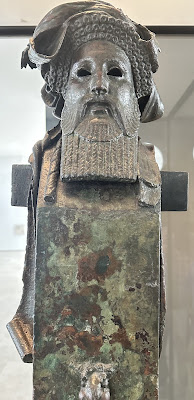














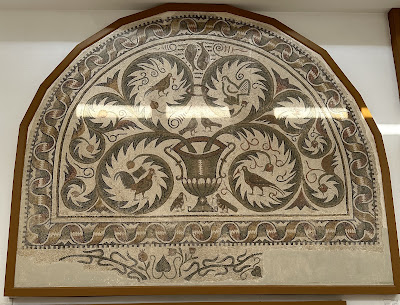
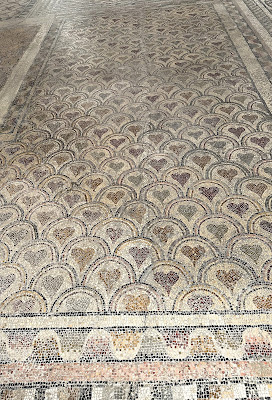







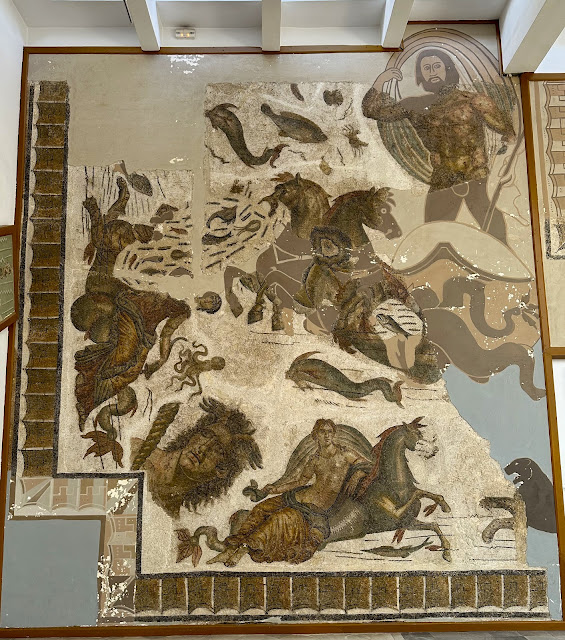




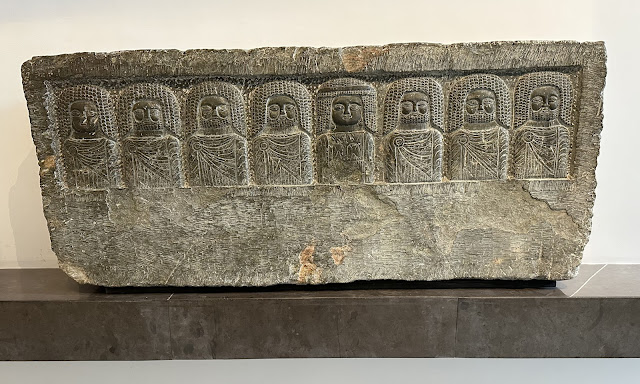













































I loved the Bardo. I love mosaics and some of them there are massive and magnificent. The baptismal font of mosaics is incredible. The Bardo just recently opened from being closed. We were fortunate to get in.
ReplyDelete